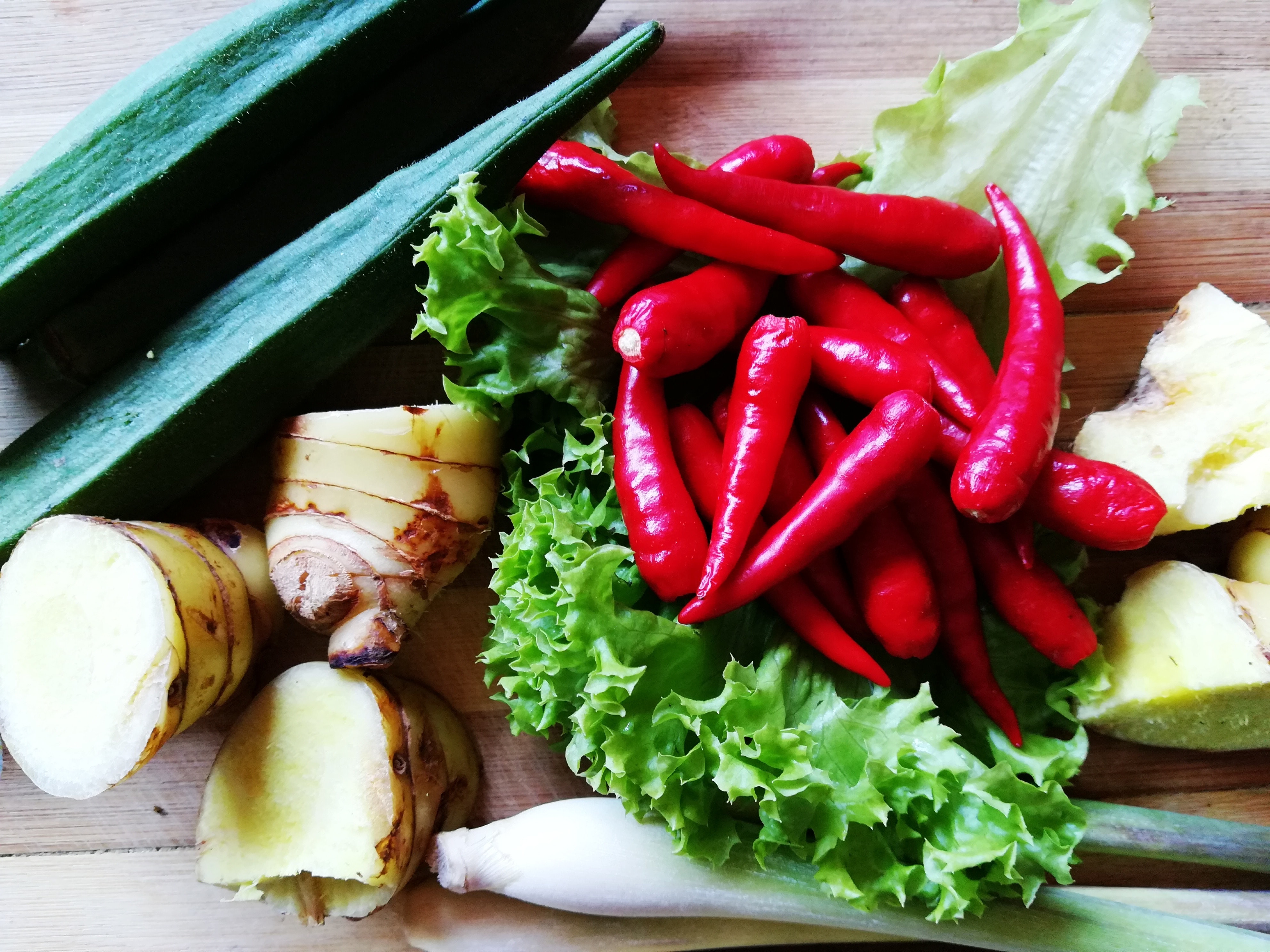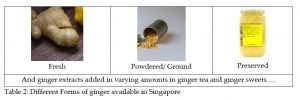
Health Benefits of Chili and Ginger
Written by: Gloria Lek
In this article, I am going to discuss the health benefits of using chili and ginger in our diet and lastly, demonstrate a healthier version of Laksa Assam Noodle Soup, made from scratch.
What are Spices?
Spices come from various plant parts such as the bark, berries, fruits, seeds, roots and rhizomes. They are low in calories and high in vitamins and minerals, making spices a great flavour booster and an all-round healthy addition to any meal. For best flavour, it is advised to be bought whole (not grounded). The process of grinding releases flavourful oils which can cause the spice to lose its pungency over time.
Different forms of Chili available in Singapore and the health benefits of chili consumption
Chilis can be prepared in a variety of ways. Fresh chilis can be sliced to be used in dishes while dried chilis can be crushed to form flakes and grinded to form powder. Table 1 below illustrates the common forms of chili found in local supermarkets.

Chilies are excellent sources of vitamin A, B, C and E and minerals including Folate, Potassium and Thiamine (Vitamin B1). In traditional Indian home remedies, chilies are often used to stimulate the appetite and aid digestion as they help to detoxify the gastrointestinal tract. Chilies are also often used to relieve nasal and lung congestion by increasing metabolism. It dilates the airway to reduce wheezing and breathing difficulties.
Health Benefits of Chili
Capsaicinoids are found to exert multiple pharmacological and physiological effects including these shown below.
- Cardiovascular benefits
The antioxidant property of capsaicinoids also contributes to their beneficial effects on cardiovascular system. The oxidation of low density lipoprotein (LDL) is believed to be the initiating factor for the development and progression of atherosclerosis. Regular consumption of chilli for 4 weeks has been found to increase the resistance of serum lipoproteins to oxidation in adult men and women (Ahuja and Ball, 2006). These reports support the antioxidant property of capsaicinoids and their potential clinical value on the prevention of cardiovascular diseases, such as atherosclerosis and coronary heart disease in particular.
- Weight reduction
Chili peppers are well known for their ability to produce a sensation of heat and increase energy expenditure when eaten. Since thermogenesis and energy metabolism play an important role in the regulation of obesity, chili peppers, therefore, are thought as the potential foods for obesity management. There is plenty of evidence that Capsaicinoids possess anti-obesity properties. Capsaicinoids could play a role in weight management alongside exercise and diet.
Removing the inside pithy white membrane and seeds will help to reduce pungency since Capsaicinoids are found on these parts. When handling chili, it is important to wash your hands thoroughly with soap and water before touching your eyes as the chili oils could linger. In most Asian spice blends, such as Laksa paste, Harissa and curry paste, chili is one of the most common ingredients added. The video below shows how chili with other spices were combined to make a fusion of two of the local food delights.
VIDEO
Different ginger forms avail in Singapore – powder, drink, fresh and sweets
Rhizomes like ginger and galangal can be sliced, chopped, grated or used in juicing. Fresh ginger should be plump and solid with smooth, taut skin. Table 2 below illustrates the various preparation methods of ginger found in local supermarkets.

Comparing young ginger vs old ginger
Fresh young ginger is Gingerol, the most prominent phytonutrient in ginger root is more concentrated in old ginger.
| Young Ginger | Old Ginger |
|
|
Galangal is another spice that resembles ginger with a darker colour. Their biggest difference is their taste: galangal has a sharp citrusy, almost piney flavour, while ginger is fresh, pungently spicy, and barely sweet
Health benefits of Ginger
Spices such as ginger are common remedies used in traditional medicines or ingredients of pharmacological preparations to cure digestive disorders.
- Improved glycemic indices and Total antioxidant capacity
The beneficial effect of ginger supplementation on glycemic indices in Iranian patients with type 2 diabetes had been reported. Three months supplementation of ginger (3 g of powdered ginger daily) improved glycemic indices, total antioxidant capacity and serum para-oxonase activity in patients with type 2 diabetes. (Srinivasan, 2017)
- Anti-inflammatory property
A few clinical studies, mostly randomized controlled trials, investigating the beneficial effect of ginger in ameliorating arthritic knee pain in patients with symptomatic osteoarthritis and rheumatoid arthritis have been reported. Anti-Inflammatory effect of ginger extract (170 mg; thrice a day) was observed in 56 osteoarthritic patients as indicated by reduced arthritic knee pain, although the effectiveness was lesser than that of ibuprofen (Bliddal et al, 2000). Moderate nevertheless statistically significant reduction in knee pain by ginger extract (1 g/day for 6-month) is reported in subsequent clinical studies (Wigler, 2003). These trials found that the pain level of the participants in the intervention group was significantly lower than that in the placebo group. In addition, decreased use of nonsteroidal anti-inflammatory drugs was also observed, which means that the consumption of medication reduced over time with ginger extract of 200 and 300 mg, twice daily for 8 weeks. (Sohail et al. ,2005)
Conclusion
In conclusion, do experiment around with spices (either in their fresh or dried form) when cooking to cut down on adding salt or other sodium-containing sauces. Always taste the dish before adding more condiments. You might be surprised at how good the flavour already is, all with natural fresh ingredients.
References
1. Shidfar, A. Rajab, T. Rahideh, N. Khandouzi, S. Hosseini, S. Shidfar, The effect of ginger (Zingiber officinale) on glycemic markers in patients with type 2 diabetes, J. Compl. Integr. Med. 12 (2015) 165–170.
2. Bliddal, A. Rosetzsky, P. Schlichting, M.S. Weidner, L.A. Andersen, et al.,A randomized, placebo-controlled, cross-over study of ginger extracts and ibuprofen in osteoarthritis,Osteoarthr. Cartil. 8 (2000)9–12
3. Wigler, I. Grotto, D. Caspi, M. Yaron, The effects of Zintona EC (a ginger extract) on symptomatic gonarthritis, Osteoarthr. Cartil. 11 (2003) 783–789
4. T. Sohail, M.I. Chaudhry, M.K. Usman, T. Mian, M.N. Ishaq, Efficacy and tolerance of atrisin in degenerative and inflammatory joint disorders, Phytother. Res. 19 (2005) 365–368.
5. D. Altman, K.C. Marcussen, Effects of a ginger extract on knee pain in patients with osteoarthritis, Arthritis Rheum. 44 (2001) 2531–2538.
6. Srinivasan, K. (2017). Ginger rhizomes (Zingiber officinale): A spice with multiple health beneficial potentials. PharmaNutrition, 5(1), 18-28. doi:10.1016/j.phanu.2017.01.001
7. Mazidi, M., Gao, H., Rezaie, P., & Ferns, G. A. (2016). The effect of ginger supplementation on serum C-reactive protein, lipid profile and glycaemia: A systematic review and meta-analysis. Food & Nutrition Research, 60(1), 32613. doi:10.3402/fnr.v60.32613


